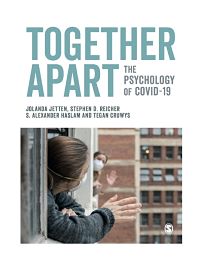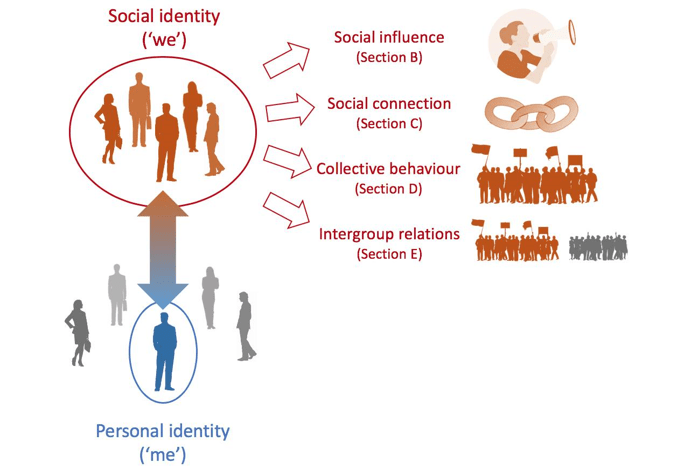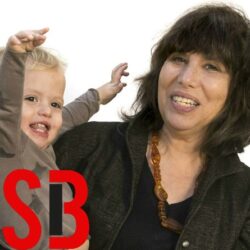A Social Identity Analysis of COVID-19: Introduction to ‘Together Apart’
Plague was the concern of all of us…. Thus, for example, a feeling normally as individual as the ache of separation from those one loves suddenly became a feeling in which all shared alike and — together with fear — the greatest affliction of the long period of exile that lay ahead. (Camus, The Plague, 1947, p.61, emphasis added)
As Albert Camus tells it in The Plague, as soon as contagious disease swept through the Algerian city of Oran and the city went into lockdown, the behaviour of the residents changed. Emotions that had previously been experienced individually became emotions shared by all. Likewise, if we are trying to understand responses to a challenge where (at least potentially) “we are all in this together”, we need a theoretical analysis that help us to get to grips with the nature of that shared and collective experience. Above all else, then, this is what this book seeks to provide.
The social identity approach (consisting of social identity theory; Tajfel & Turner, 1979, and its extension self-categorization theory; Turner et al., 1987, 1994) is well suited to this task. In particular, as we outline below, this theoretical framework provides a parsimonious explanation for many of the COVID-19 puzzles that we identified in Chapter 1: how the virus has changed the way we look at ourselves and others, as well as how it has changed our relationship to the world and our sense of what we value in it. Fundamentally, what we see here is that COVID-19 has changed our notions of ‘self’ and associated calculations of ‘interest’, so that these are more inclusive of others. More particularly, whether we define ourselves as ‘us’, and if so, who is included in that definition, becomes critical to our social and health-related behaviour. But before delving into such matters, it will be helpful to consider where the social identity approach started and what exactly it is.

Writing in the early 1970s, Henri Tajfel defined social identity as “the individual’s knowledge that he [or she] belongs to certain social groups together with some emotional and value significance to him [or her] of this group membership” (1972, p.31). In other words, social identity refers to internalised group membership, that serves to define a person’s sense of ‘who they are’ in a particular social context. In contrast, personal identity refers to a person’s internalised sense of their individuality (e.g., their idiosyncratic abilities and tastes; Turner, 1982). Practically speaking, this means that when people see themselves in terms of their social identity, they self-define in terms of “we” than in terms of “I”. It also means that when people act in terms of their social identity they interact with others on the basis of an identity that they either share (as “us” ingroup members) or do not share (as “us” ingroup members versus “them” outgroup members).
Why would this distinction between personal and social identity matter in the context of responses to COVID-19? As we noted in Chapter 1, one important reason is that during the pandemic many of the behaviours engaged in can be seen as motivated much more by their social identity than by their personal identity.
To give an example, if a young woman, Sophie, were to assess her situation purely in terms of her personal identity, it would be hard to understand why she would engage in physical distancing and stop having face-to-face get-togethers with her friends. Why would she stay at home when she is personally in a very low-risk group? Indeed, even if she were to become infected, statistically speaking, her chance of survival would be very high. To understand Sophie’s behaviour, we need to look at the groups and categories to which she belongs. When we do, we can see that she stays at home because she identifies with her family, friendship groups, workplace, community, and country and these groups all endorse a norm of “staying home”. In other words, when we look at her social identities — the groups to which she belongs and identifies with and the groups whose destiny she shares — the reasons for Sophie’s choices become clearer. Indeed, this examination makes it clear that her behaviour is determined not by a concern about becoming personally infected with the virus but by a desire to protect other members of the groups to which she belongs. This sentiment is echoed by Camus in The Plague where he observes:
No longer were there individual destinies; only a collective destiny, made of plague and emotions shared by all. (Camus, 1947, p.161)
Moreover, it is not just that responses to COVID-19 typically involve considerations that are relevant to “us” rather than “me”; it is also clear that effectively combatting the virus (whether reducing its spread or mitigating its negative consequences) requires a focus on the group and not the individual. This is an observation that many leaders have made. For example, Magus Berntsson, the President of the Assembly of European Regions remarked:
It is only through cooperation that we can successfully battle this virus and deal with its long-term societal and economic effects. Nationalist and protectionist strategies will not succeed against an ‘enemy’ that does not respect borders. Coordination, cooperation, sharing of best practices and solidarity are needed now more than ever. (Assembly of European Regions, 2020)
The social identity approach is well placed to tackle the challenge of understanding how collective level solidarity and cooperation can be achieved. In the remainder of this chapter, we outline the key premises of the social identity approach that are relevant to the psychology of COVID-19. In this, our main objectives are (a) to map out the forces that determine how people are able to act as group members rather than as individuals, and (b) to understand what the distinctive psychological and behavioural consequences of acting in terms of social identity are. In other words, what leads us to see ourselves as members of a given community (e.g., as ‘Oranians under siege’) and how does this change what we think, feel, and do?
We know who we are (and what to do) by comparing ‘us’ with ‘them’
The above observations give an initial sense of why social identity — a sense of ‘us-ness’ — is so important for the psychology of COVID-19. But when do we see ourselves as one ‘us’ rather than many ‘I’s? And how do we know exactly who and what ‘us’ is?
Some initial answers to these questions were provided by a series of laboratory studies that Tajfel and colleagues conducted in the early 1970s — the so-called ‘minimal group’ studies (Tajfel et al., 1971). The participants in these were assigned to groups on the basis of ostensibly trivial criteria such as their preference for the abstract painters Klee or Kandinsky. After this, they had to award points (signifying small amounts of money) to an anonymous member of their own group and to an anonymous member of the other group. The participants were never able to allocate money to themselves and so this ruled out self-interest and personal economic gain as determinants of their allocation behaviour. All they knew was that they were allocating money either to ‘us’ (without benefiting from that personally) or to ‘them’.
The robust finding that emerged from these studies was that even these most minimal of conditions were sufficient to encourage group behaviour. In particular, participants tended to award more points to a person from their ingroup (‘us’) than to a member of the outgroup (‘them’). Tajfel and Turner (1979) explained these findings by arguing that acting as group members (i.e., in terms of a social identity as a member of the Klee group) helped to “create and define the individual’s place in society” (pp. 40-41). More generally, they argued that often we only know who ‘we’ are by knowing who we are not. As Tajfel put it:
Distinction from the ‘other’ category [e.g., the Kandinsky group] provided an identity for their own group, and thus some kind of meaning to an otherwise empty situation. (1972, pp. 39-40, emphasis added)
This observation provided a platform for two theoretical principles which form the core of social identity theory. First, groups define their place and standing in the social world through comparisons with other relevant groups and, second, the outcome of that social comparison is important because group members strive for a sense of social identity that is positive, distinct and enduring (Tajfel & Turner, 1979). In other words, we want ‘us’ to be better than, different from, and more durable than, ‘them’.
There is plenty of evidence of these motivations at work in the context of COVID-19. In particular, in trying to determine an optimal response to the pandemic, many countries, communities and friendship groups compare their own group to other groups — most obviously by looking at tables of infection rates, deaths and testing numbers (e.g., those provided by Johns Hopkins University, 2020). The outcome of that comparison is important, because the sense that one’s group (e.g., one’s country or region) is doing poorly or well will dictate, among other things, whether a group feels it can relax restrictions on social gathering or else needs to tighten them.
We also compare our ingroups to those outgroups that are seen to provide a relevantbasis for social comparison. Indeed, because many countries did not see China as a relevant comparison group when the first outbreak of COVID-19 was reported from Wuhan, they did not take appropriate measures to stop the spread of the virus. For example, it has been argued that one reason why Italy was slow to respond to the outbreak was that its citizens did not compare themselves with China but instead with other European countries. As Italy’s Undersecretary of State for Health, Sandra Zampa, observed:
Most importantly, Italy looked at the example of China, Ms. Zampa said, not as a practical warning, but as a “science fiction movie that had nothing to do with us.” And when the virus exploded, Europe, she said, “looked at us the same way we looked at China. (Horowitz et al., 2020)
In the context of such comparisons, groups and their leaders want to establish a sense of positive social identity by making it clear that they have responded to the outbreak better than other groups. Accordingly, throughout the crisis, many national leaders have pointed to ways in which their own country’s response has been superior to that of others. For instance, at a press briefing on April 2, Australia’s Prime Minister, Scott Morrison boasted that “we have mobilised a testing regime better than any in the world” (Rev, 2020). Similarly, Israel’s Prime Minister, Benjamin Netanyahu, tweeted that “Israel has been ranked first in the COVID-19 Health Safety Countries Ranking on the Deep Knowledge Group website” (Weinglas, 2020). The fact that no other leaders made reference to the work of the Deep Knowledge Group speaks too to the fact that in order to achieve a positive sense of social identity, we are often very selective both in the measures we use to compare ourselves to others, and in the groups we compare ourselves with (in ways that social identity theory predicts; Tajfel & Turner, 1979). Thus, on April 27 Donald Trump claimed that “the United States has produced dramatically better health outcomes than any other country, with the possible exception of Germany” — but this was true only because he compared the U.S. with a small number of countries that had been hit hard by the first wave of the virus (e.g., Italy, Spain, the UK; Mackey, 2020).
While group members look to make intergroup comparisons which put their ingroup in a positive light, these efforts are also constrained by social reality. In particular, society is highly stratified — with some groups having a lot more status and power than others. Unlike their low-status counterparts, high-status groups by definition already compare favourably on key status-defining dimensions in ways that give them a positive social identity. It is therefore not surprising that the primary interest of advantaged groups is in maintaining and protecting their dominant position. In contrast, lower-status groups often struggle to achieve a positive identity because intergroup comparisons typically confirm their inferior status in ways that make the group unattractive and unviable. As we will see in the chapters that follow, group status is an important determinant of responses to COVID-19 — not least because this is something that the virus can threaten. In particular, groups that have a lot to lose (e.g., retail businesses, sporting bodies) can be expected to press vigorously for actions that preserve their status (e.g., ending the lockdown, financial stimulus), while those that have little to lose (e.g., environmental groups) may see the virus as an important opportunity for social change.
Social identities are shaped by history, context and influence
Social comparisons with other groups help us to understand who ‘we’ are, but which social identities, out of myriad possible ones, do we use to define ourselves in any given context? Andrew may be an academic, an active member of his local community, a Liverpool fan, and Northern Irish, but which group membership will inform his sense of self — and hence his behaviour — in any given context? Indeed, if we assume that all of these social groups embrace different norms about how to respond to COVID-19 (e.g., so that his local community supports physical distancing but his soccer team does not), how do we know which norms Andrew will internalise and comply with?
Broadly speaking, the social identity approach suggests that three sets of factors are at play here (Oakes et al., 1994). The first factor is a person’s social history. This means that Andrew is more likely to define himself in terms of a given social identity if the group membership that this relates to has been important for him and his fellow group members in the past (in self-categorization theory, this is referred to as the principle of perceiver readiness). The second factor is social context (Haslam & Turner, 1992). This means that the identities we use as a basis for self-definition need to be meaningful in the situation at hand. Andrew is more likely to define himself as a Liverpool fan when he is watching a football match (especially with other Liverpool fans) than when at an academic conference. In the context of COVID-19, he is also more likely to define himself as Irish if he sees the situation he confronts as one which other Irish people are confronting too, and as being different from that faced by members of other groups (e.g., Germans; the principle of fit). The third factor is social influence (Reicher et al., 2005). This means that the way we define ourselves is also shaped by the ways that others — particularly other ingroup members — encourage us to define ourselves. For example, if other people that Andrew identifies with define themselves as British, rather than Northern Irish (and make this identity seem more fitting), then he is more likely to do so too.
Yet while these three factors interact to determine which social identities we use to define ourselves, features of the broader socio-structural context also determine whether we define ourselves primarily as group members or as individuals. Tajfel and Turner (1979) argued that people are more likely to define themselves as group members when they see this as the best way to achieve a positive sense of identity. At least three factors have a bearing on this: (1) the perceived status of the group, (2) the perceived permeability of group boundaries (i.e., opportunity to leave the group), and (3) the possibility of changing the group’s circumstances. These factors make people less likely to define themselves in terms of a given group membership if that group has low status, if it is possible to leave the group, or if the group’s status seems unlikely to change (Ellemers, 1993).
This also means that if a group is unattractive (e.g., because it is stigmatised or disadvantaged) then its members are likely to try to ‘go it alone’ if they sense that this offers them the best pathway to self-advancement. Indeed, this way of thinking can be seen to underpin — and to have been reinforced by — individualistic ideologies of meritocracy and personal mobility that have come to the fore in recent decades (particularly in Western societies). These were famously embraced by the Conservative British Prime Minister Margaret Thatcher in her observation that:
There is no such thing as society. There are individual men and women, and there are families. And no government can do anything except through people, and people must look to themselves first. It’s our duty to look after ourselves. (Evans, 2004, p.106)
Such a philosophy encourages people to act in terms of personal rather than social identity — and therefore to turn their back on their groups and the plight of fellow group members. If you are a woman or black and you experience sexism or racism, do not work with others to fight for social justice. Just lean in or walk on by.
As we have already seen, in the face of a pandemic, such a mindset has the potential to be fatal. At the same time (and in many ways rather fortunately), in pandemics and other large-scale disasters the factors that we have discussed also serve to make people more likely to define themselves in terms of shared social identity (Drury, 2012). In particular, the context is one that makes shared group memberships (e.g., those based on nationality) both more meaningful and more inescapable. Moreover, because leaders recognise the value of social identity as a resource for bringing people together, this is something that they typically seek to cultivate. Thus it was no accident that early on in the pandemic, Boris Johnson chose to deliberately push back against his Conservative predecessor’s earlier pronouncement by declaring that, indeed, “there really is such a thing as society” (Braddock, 2020). In the process, he signalled a more inclusive approach to the COVID-19 crisis and opened the door to a broad set of positive social resources which flow from people seeing themselves — and acting — not as isolated individuals but as members of a collective who are ‘all in this together’.
Social identity provides a platform for social influence, social connection, collective action and intergroup relations
Having sketched out the processes that lead people to define themselves in terms of a particular group membership, the obvious question is why this matters — and in particular, why it helps us understand the psychology of COVID-19. In many ways, this is a question that the rest of this book seeks to answer. In particular, we seek to show how the social identity approach provides the conceptual tools to address each of the key issues that we raised at the end the previous chapter. In the sections that follow we will therefore show how an internalised sense of group membership (i.e., self-categorization in terms of social identity — or a sense of ‘us-ness’) is the basis for (a) social influence and effective leadership, (b) social connection and hence health, (c) solidarity and collective behaviour, and (d) long-term social relations between groups. These links are represented schematically in Figure 2.

A first point to note is that social identity is a platform for social influence (Turner, 1991). More specifically, as we explain in some detail in Section B, our willingness to listen to, and be guided by, another person (in particular, a leader) is contingent on us (a) defining ourselves in terms of social identity and then (b) believing that that person is representative of it (so that, in the language of categorization theory, they are prototypical of the group; Rosch, 1978). In these terms, it is clear that effective leadership during the COVID-19 crisis has centred on leaders being able both to develop a sense of a shared identity (a sense that “we are in this together”) and to be seen as “one of us”. This is seen, for example, in the words and actions of Scandinavian Prime Ministers, Mette Frederiksen (Denmark), Sanna Marin (Finland) and Erna Solberg (Norway) — all of whom went to great efforts both to bind their societies together and to be seen to stand with them (e.g., Tu, 2020). This in turn allowed them to enforce tough physical distancing measures because, for their citizens, compliance did not feel like a personal sacrifice but as the ‘right and proper thing to do to protect us’.
As well as being the basis for influence, even more fundamentally, social identity is a basis for social connection. Indeed, while early social identity theorising (in the wake of the minimal groups studies) focused on explaining intergroup hostility and discrimination, it is increasingly recognised that the groups we identify with provide us with important psychological resources (Haslam et al., 2018; Jetten et al., 2012). In particular, they help us to ‘know who we are’ in ways that give our lives meaning and purpose, and a sense of self-worth and control. Our ingroups are also an important source of social support in times of stress, as we have seen throughout the COVID-19 crisis. However, in this context, we also see an important corollary of this — namely that when we are cut off from groups that are important to us (e.g., our extended family, friends, work teams, sports clubs), this can have negative consequences for our health and well-being. While COVID-19 clearly harms people’s health directly, so too can the social isolation that results from the measures used to deal with it. These are issues that we work through in Section C. Here we also examine whether defining groups as ingroups or outgroups leads us to see them as either a source of safety and support, or of threat and harm — in ways that have profound implications for health-relevant behaviour.
Will COVID-19 bring us closer together or pull us apart? Speaking to the latter possibility, there has been widespread discussion of the ways in which fears of contamination can bring out the worst in us (e.g., Rathje, 2020). The media has also extensively reported on hoarding and panic buying in ways that sometimes give the impression that during this pandemic, everyone is out for themselves. However, in many ways the bigger picture is a much more positive one. So, despite the fact that every other human is a potential source of infection (and hence a threat to life), during the pandemic we have witnessed a range of novel and powerful forms of solidarity and collective behaviour in communities and society more generally. In ways that we explain in Section D, all of these can be understood as manifestations of an emergent sense of shared social identity. This indeed, explains why panic and selfishness are the exception not the rule; and why 2020’s main stories have been instead of collective efficacy and resilience.
Yet as we noted in Chapter 1, there is a dark side to COVID-19, too. Not least, this is because the virus has put a magnifying glass on social inequalities. Indeed, it is clear that the suffering brought about by the virus has fallen unfairly on the shoulders of lower-status groups in society and the lower-status countries. In ways that social identity theory would predict, this is a recipe for social unrest and challenges to the status quo. Some predict that social discontent will flare up as soon as bans are lifted and individuals are free to move again. As Kluth (2020) observes:
It would be naive to think that, once this medical emergency is over, either individual countries or the world can carry on as before. Anger and bitterness will find new outlets. Early harbingers include millions of Brazilians banging pots and pans from their windows to protest against their government, or Lebanese prisoners rioting in their overcrowded jails.
We put these possibilities under the microscope in Section E. In particular, we explore how COVID-19 is likely to impact intergroup relations by changing things that social identity research tells us are important: the permeability of group boundaries, the legitimacy of intergroup relations, and the nature of the social identities in terms of which define ourselves (Tajfel & Turner, 1979). These shifts, we suggest, will help us understand the long-term impact of COVID-19 — not only on the forces at play in society, but also on its very structure.
































































































